
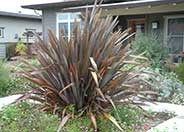
Common name:New Zealand Flax
Botanical name:Phormium tenax 'Atropurpureum'
Phormium tenax 'Atropurpureum' is an evergreen perennial. Big, dramatic plant composed of many swordlike, stiffly vertical leaves (9 ft. long, to 5 in. wide) in a fan pattern. Leaves are purple red. Flowers stems reach high above leaves, bearing clusters of 1-2 in. blossoms in dark red to yellow.
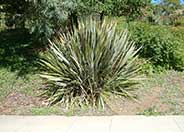
Common name:New Zealand Flax
Botanical name:Phormium tenax
New Zealand Flax is a large, bold plant with stiffly vertical, sword-like, green leaves that arise from its base. It should be grown under full sun for best color. Varieties will offer different growth habits and leaf color.
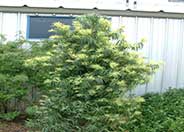
Common name:Long-leafed Yellowwood
Botanical name:Podocarpus henkelii
This handsome evergreen tree will grow 30-50' high x 15-20' wide. It has beautiful drooping, shiny, green foliage year-round. Leaves are slightly crescent-shaped, 5-7' long when young, shorter when plant matures. Attractive container plant.
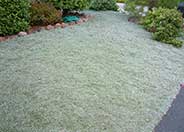
Common name:Dymondia, Rock Ditty
Botanical name:Dymondia margaretae
This foliage is gray/green/silvery and the margaretae is a very dense, mat forming groundcover. It tolerates drought, cold, salt spray and poor soils. It's deep rooted and produces small, inconspicuous yellow flowers. Great for use in between stepping stones or pavers.
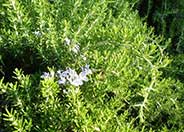
Common name:Rosemary
Botanical name:Rosmarinus officinalis
Rosemary is hardy in full sun areas where winter temperatures do not drop below 10 degrees F. They can be grown in a clay pot with well-drained, porous soil in bright indoor light, and will also flourish on the backporch in spring, summer and fall. Its beautiful, slowly trailing stems and shiny slender leaves are perfect for showing off the small light blue flowers that blossom in the summer. -Holland WIldflower Farm
An efficient watering system applies the right amount of water to the right parts of the garden at the right time. This conserves water and saves you money.
Click in the green box for more information
| Designer: | Phormium and Friends |
Photographer: GardenSoft |
Maintain a two to four inch layer of mulch on the soil surface to reduce weeds, infiltrate rain water, and reduce compaction.
Adjust sprinklers to avoid watering sidewalks and driveways.
Attract, or buy beneficial insects such as ladybugs and lacewings to control pest outbreaks in your garden.